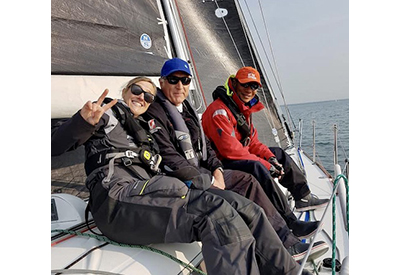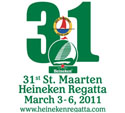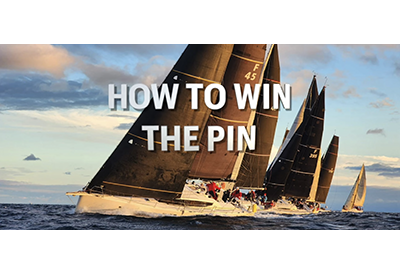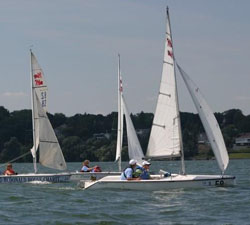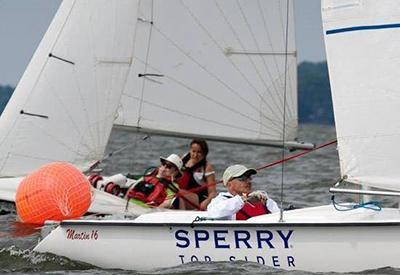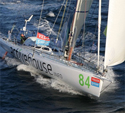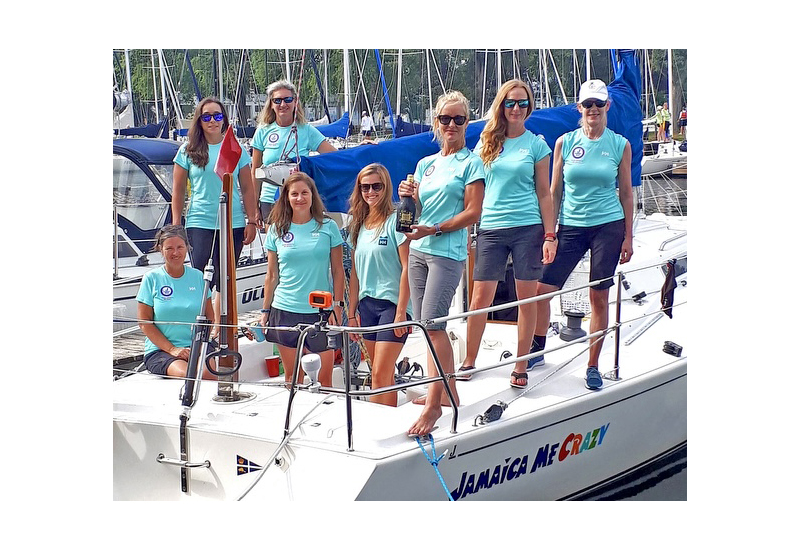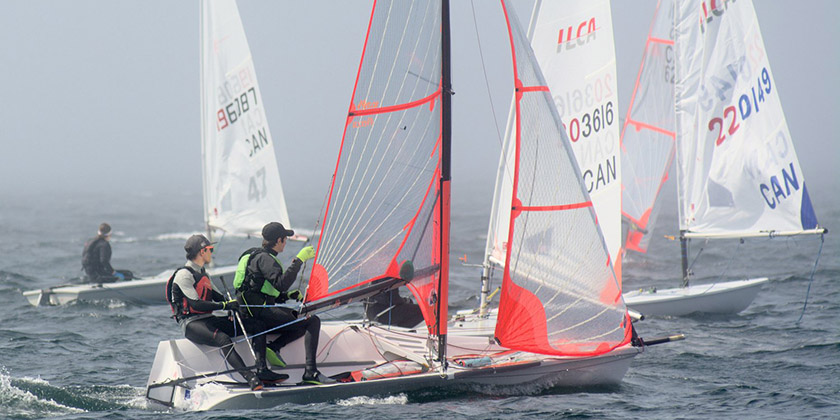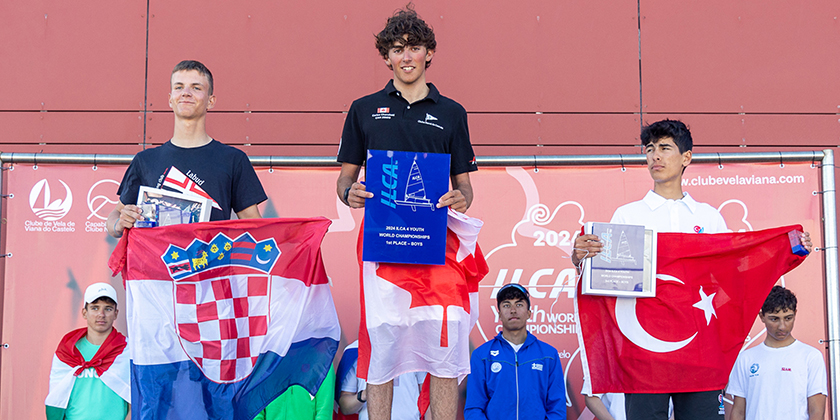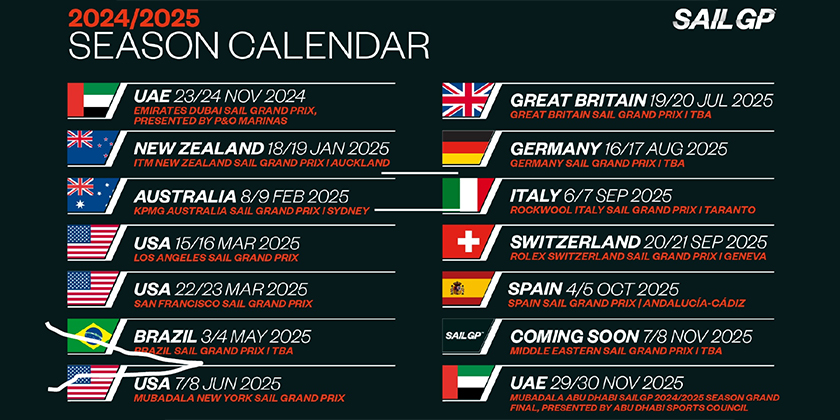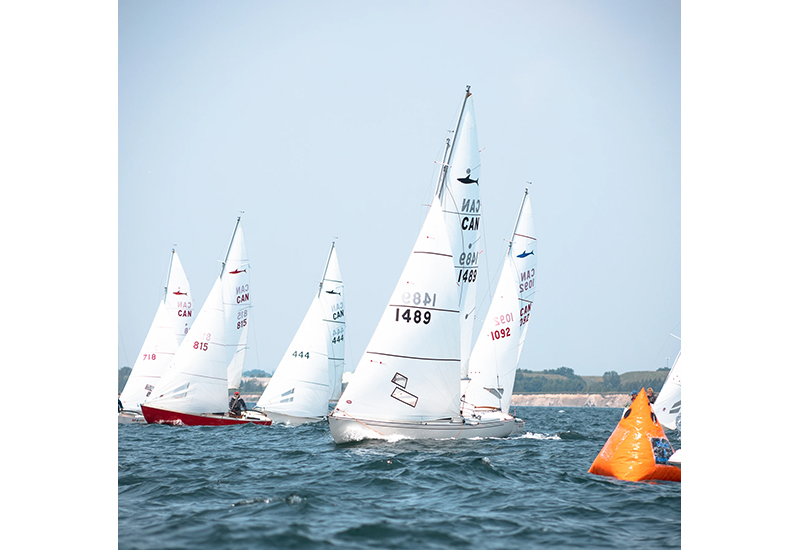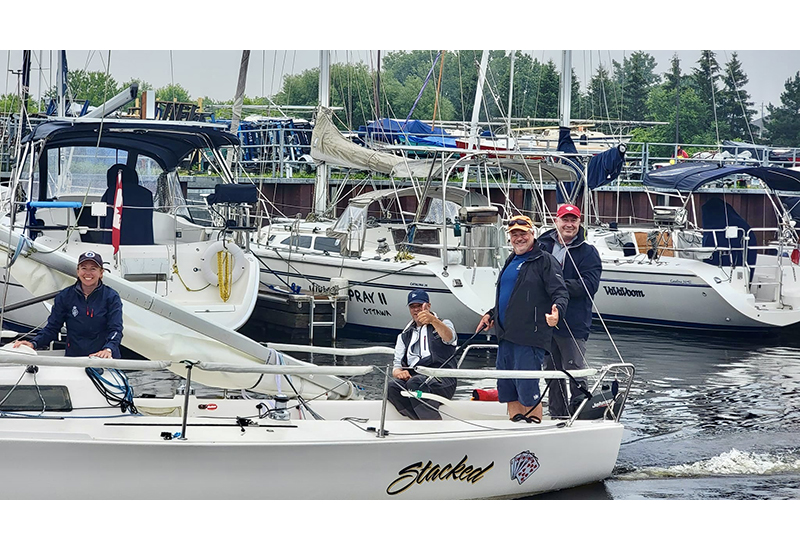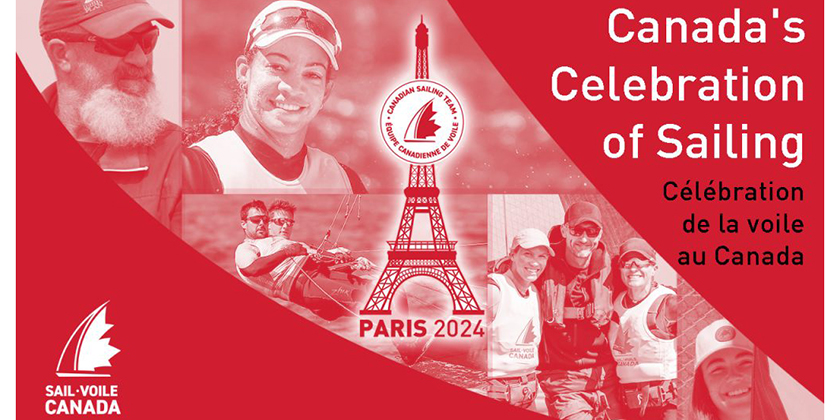2008 Lake Ontario 300 – A Personal View
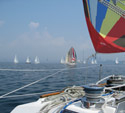
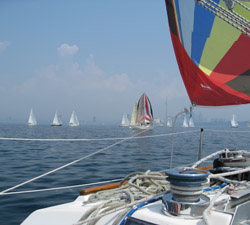 Saturday morning finally comes; I have been rolling and tossing all night with much anticipation for the annual Solmar Lake Ontario 300 race. I kiss my family goodbye and head for the club. However, as I near the entrance, I gasp at my first sight of the lake; actually, I gasped because I couldn't even see the lake. Thick fog just sat there; not even a whisper of wind to push it out of the way. As a member of the organizing committee, I start to panic.
Saturday morning finally comes; I have been rolling and tossing all night with much anticipation for the annual Solmar Lake Ontario 300 race. I kiss my family goodbye and head for the club. However, as I near the entrance, I gasp at my first sight of the lake; actually, I gasped because I couldn't even see the lake. Thick fog just sat there; not even a whisper of wind to push it out of the way. As a member of the organizing committee, I start to panic.
The boat, a CS30, Nick's Café, has been a racing fixture at PCYC for the past 17 years. Patrick Muise, the owner, is a veteran of many LO300 races; this will be my 4th race with this crew: Tom O'Brien, John Danahy and Andrew Newman. Last minute provisioning is taking place when I get back to the boat having spent some time with the organizing team discussing options for a light air start. However, the fog has now lifted and a very light breeze is filling in from the west.
Nick's Cafe leaves the dock around 0930. The start sequence will take a while; we figure out the timing for our start in the 'Fully Crewed Spinnaker' division and set our watches. We plan our route based on the current wind and decide to use the light air spinnaker to make good time towards the Gibraltar Point buoy, the first mark. A light aircraft is buzzing around in the sky looking for good photo opportunities; various media crews in small power boats are trying to stay out of the way with similar goals on the water.
After an uneventful start, we are finally racing; the spinnaker went up as we crossed the line and we are pointing straight for the first mark. The fleet has already spread out ahead of us; crews with different strategies are either heading out on the lake or staying closer to shore for better winds. We opt to sail the most direct route and this seems to be paying off. The crew pays attention to sail trim as we expect a busy rounding at Gibraltar where many boats will be getting closer to each other (with the faster boats starting last, but eventually catching up); we'd like to get there well ahead of the chaotic situation that we anticipate.
Our worst fears come to reality as we get near the familiar large red buoy; not only has the fleet come together, but the wind has died down to a whisper. Many boats ahead of us are standing up with flat sails and can barely maintain steerage; we find a lane close to the inside and manage to get by unscathed; we quickly change our course to a beam reach to get away from the mayhem and steer towards the Whitby mark. As we get closer, we plan our watch routine; Andrew, our resident project manager, has been improving our schedule of 3 up and 2 down for the past few years and it has proven successful and efficient in the past. We have an early dinner – Tom's famous chicken couscous – and settle in for the evening sail to Whitby. As much as I would like to stay up for the next mark rounding, I reluctantly go down to my bunk, but don't sleep very well.
So after the rounding at Whitby, do we stay close to shore or go out in the lake? In the fickle breeze, we gamble and hope to find better winds close to shore. As expected, the first night greets us with a mixed bag of conditions, including much rain; after a short period of very light winds, we find better conditions and carry on deep in the bay towards Presqu'Ile Provincial Park near Brighton. In daylight, we opt to stay close to shore as we go around Prince Edward County; I'm at the helm as we near Point Petre; we are navigating in shallow waters and turn on the depth sounder – only 12 feet below. We cautiously carry on to cut the corner when the bottom comes up to 7 feet; we quickly decide to tack away from shore; dangerously close. Later, John decides to download the handheld GPS tack onto his trusty laptop and notices that earlier in the day, we had sailed precariously close the the Scotch Bonnet Shoals but, fortunately, didn't touch bottom.
Point Petre now comfortably in our wake, we start planning our next move around the "Ducks" (the Duck Islands). We have to be ready for night time navigation of the treacherous waters surrounding Main Duck and Yorkshire Islands; the area can be confusing, particularly because the in-bound shipping St-Lawrence Seaway channel lies between us and the islands. At night, the area can turn into a "discotheque" – as Pat referred to it a few years ago – there were red and green lights everywhere on the water. It was difficult to distinguish between stationary navigation aid lights and running lights on yachts. The cabin white lights of a rapidly moving freighter also added to the general confusion on board. We identify our first reference point, the MM2 red buoy that marks the inbound freighter channel; to our relief, we found the buoy quickly and were better able to concentrate on boat speed. The lighthouse on Main Duck was our next target; we gave it a wide berth to round the ominous looking island at night and set our sight on the eastern tip of Yorkshire Island in the distance. We tiptoed our way past the shallow waters surrounding Yorkshire before setting the spinnaker and turning Nick's Café on a new course – due south towards Oswego in New York State.
The downwind run is taking the crew into new LO300 territories; this is a new leg of the course and no one knows what to expect. Favourable northeasterly winds let us drive the boat at a good pace. The buoy light appears before the sun comes up; we quickly round the mark navigating shallow waters immediately beyond it. Our next goal is the shore beyond Rochester; we opt to cross the large bay in a straight line; we show good progress until the wind dies in the early morning. We desperately head out into the lake, only to come back inshore after a few futile hours in hope of finding better conditions. We are determined to maintain focus and keep the boat moving; this requires much team work and constant effort, but we persevere while scrutinizing the horizon to determine how our direct competitors might have fared. We are still a good distance from shore and cellular phone service is not sufficiently reliable to contact anyone for an update. We are well aware that everyone at home is following the event on the Internet; they are either second guessing our decisions or applauding our progress.
It will be hours before we find out we are second in our division; Folichon, Ian McAllister's C&C 34, our club racing nemesis at PCYC, has successfully gone out into the lake and found better winds and is 7 miles ahead by the end of the day. This piece of good news, along with improving weather, has raised our spirits; under the current conditions, Folichon is only 2 hours ahead of us and the chase is still on. My standard lamb curry dinner from the previous night is long gone by the time we settle in front of John's chili (although we all know his wife Andrea made it); it's still a long way to the Niagara mark. Despite the light winds, Nick's Cafe makes steady, albeit slow, progress though the night; an average of little over 3 knots gets us in within sight of the familiar Niagara red buoy shortly after 0900 the next morning.
The run back home is familiar and the boat seems to know the way; this time, we're paying particular attention to our VMG (velocity made good), which, under the current wind direction, is pointing us a bit high of the mark but with better boat speed. The end is near, or so we think.
Everyone is back on deck and involved in racing again; a couple of large freighters docked at the Clarkson piers prevent us steering a straight course to the finish line. As we pass the freighters, the wind decides to play its last card and dies. We get closer to shore, expecting some remnants of breeze to carry us to the finish barely a mile away, but we quickly find ourselves with zero boat speed and no forward progress.
John notices that the lee shore appears to be getting closer, a quick glance a the GPS confirms his fear: we are drifting in an adverse current towards the Mississauga shoreline. There is only one inevitable option: drop the anchor before hitting bottom. Tom lets the anchor down and we spin around for 20 minutes patiently waiting for the wind gods to have pity on us. Although we can almost waive to the race committee boat, we radio them describing our plight; once we finally retrieve the anchor, I swear I heard them cheer from their shore station at the end of Lakefront Promenade. We finally crossed the finish line just before dinner on our fourth day; this has been our longest LO300 race yet at just over 80 hours, but I'm convinced we'll all be back next year.

